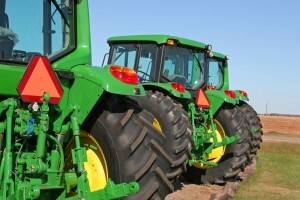 guest blog by, Tracy Schlater of Farm Safety For Just Kids
guest blog by, Tracy Schlater of Farm Safety For Just Kids
Safety on rural roads largely depends on knowing what the other vehicle is going to do. Turn signals and brake lights are the only means we have of alerting others to our actions, and I learned that lesson – the hard way – shortly after getting my driver’s license at age 16.
 On my way home from school, I was following a pickup hauling a couple of grain wagons on the gravel road leading to my family’s farm. There was a field drive coming up on the left and a farmhouse drive to the right. As we approached the intersection where the two driveways met the road, the driver of the pickup moved to the left side of the road.
On my way home from school, I was following a pickup hauling a couple of grain wagons on the gravel road leading to my family’s farm. There was a field drive coming up on the left and a farmhouse drive to the right. As we approached the intersection where the two driveways met the road, the driver of the pickup moved to the left side of the road.
Since he moved left, my 16-year-old self thought he was turning into the field drive on the left. I assumed that he moved into the oncoming “lane” of our gravel road, so I wouldn’t have to slow down while he made his turn.
I was wrong.
He was swinging wide to make the right hand turn into the farm yard without taking out the mailbox on the corner. His turn would have been obvious had the signal been working on his wagons. I was seconds from plowing into the passenger side of his pick up as he made his turn.
My mistake was making an assumption. I should have slowed down long enough to see his next move. I’m fortunate to have learned that lesson at such a young age without the costly implications of an accident.
About one-third of fatal tractor accidents occur on public roads, according to the National Safety Council. That’s why I’d like to share the following tips for sharing the road safely this harvest season.
What’s the best way to share the road?
- Plan the BEST route; avoid busy streets and towns when possible
- You MUST allow 1/2 the roadway to oncoming traffic AND behind you
- Try to move equipment during daylight hours whenever possible. Avoid moving farm equipment on public roads between sunset and sunrise or anytime when visibility is limited to 500 feet.
What lighting is required on farm equipment and wagons?
- DOT regulations state you must have at least 1 solid red light on the rear of an ag trailer
- Properly light your farm equipment. Ensure turn signals, headlights and taillights conform to state vehicle codes.
- Use amber flashers to provide warning to motorists that hazards may exist.
- Have slow moving vehicle emblems and reflectors in place on all tractors and implements.
- Emblems should be clean and in good condition; SMV signs are required for speeds less than 35 mph.
- **Speeds greater than 35 mph, signs need to be covered or removed.
- Make sure your load does not obscure lights and warning devices. Pay special attention to the outward edge of equipment such as knives.
How should you prepare your drivers?
- DON’T ASSUME your drivers know the hazards of large equipment on the road.
- Prepare selected maps for your drivers so you can avoid narrow bridges, blind hills and generally unsafe areas along the way
Start with a PLAN and make sure your drivers know what you expect of them in terms of safe passage.
